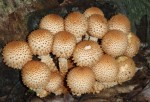 It never ceases to amaze me just what one can find in the natural world when they look beyond what it is they intended to find; to widen the gaze and focus on a much bigger picture. A recent trip to locate Timber rattlesnakes for our population and reproductive assessment survey reminded me of that very thing. It was what I had no intention of finding that had left me awe inspired. Although no reptiles were found, I did get a greater appreciation for those things that we tend to dismiss as inanimate, but quite the contrary, are growing at a great rate of speed on the forest floor. On that specific trek, you could say, there was indeed a fungus among us.
It never ceases to amaze me just what one can find in the natural world when they look beyond what it is they intended to find; to widen the gaze and focus on a much bigger picture. A recent trip to locate Timber rattlesnakes for our population and reproductive assessment survey reminded me of that very thing. It was what I had no intention of finding that had left me awe inspired. Although no reptiles were found, I did get a greater appreciation for those things that we tend to dismiss as inanimate, but quite the contrary, are growing at a great rate of speed on the forest floor. On that specific trek, you could say, there was indeed a fungus among us.
Setting it apart from other Kingdoms such as Animalia, Plantae and Bacteria, fungus is a member of an extremely large group of eukaryotic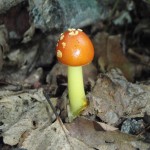 organism including yeast, mold, and mushrooms. Although little is actually known regarding the vast biodiversity of the Fungi
organism including yeast, mold, and mushrooms. Although little is actually known regarding the vast biodiversity of the Fungi 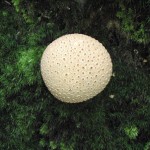 Kingdom, it is estimated to include ~ 1.5 million species of which only 5% have been classified to date. Fungi can be beneficial in food preparation such as yeast used to make breads or mold to make sake and miso, as well as edible mushrooms used for nourishment, human medicine as penicillin, pest control for regulation of harmful plant pathogens or insects, and model organisms for laboratory use; fungi has been documented to live symbiotically with organisms found in every other living Kingdom. In contrast, members of the Fungi Kingdom can be extremely toxic, even deadly; it is the chytrid fungus that is responsible for the worldwide decline in amphibian populations. Fungi can grow in some of the most extreme environmental conditions and temperatures living in land and sea, and have been found in every habitat that has been explored by man.
Kingdom, it is estimated to include ~ 1.5 million species of which only 5% have been classified to date. Fungi can be beneficial in food preparation such as yeast used to make breads or mold to make sake and miso, as well as edible mushrooms used for nourishment, human medicine as penicillin, pest control for regulation of harmful plant pathogens or insects, and model organisms for laboratory use; fungi has been documented to live symbiotically with organisms found in every other living Kingdom. In contrast, members of the Fungi Kingdom can be extremely toxic, even deadly; it is the chytrid fungus that is responsible for the worldwide decline in amphibian populations. Fungi can grow in some of the most extreme environmental conditions and temperatures living in land and sea, and have been found in every habitat that has been explored by man.
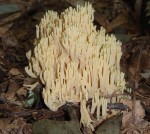 So why all of this talk about Fungi? Accompanied by my research partner and husband, Andrew Dow, and father-in-law, Roger Dow, I set off to collect data for our Timber rattlesnake project. Searching in rock outcrops and crevices we were not successful with reptiles, but were utterly amazed about what we found all around us. I almost broke the cardinal rule of an explorer: always keep your eyes open. It was Roger who began to point out the toadstools, mushrooms, and fungi that was literally everywhere. We spotted specimens on trees, among rotting vegetation, growing on moss, and on rock walls; it would be easier to list the places we did not find them. Every color and texture was represented in this fascinating fungi adventure.
So why all of this talk about Fungi? Accompanied by my research partner and husband, Andrew Dow, and father-in-law, Roger Dow, I set off to collect data for our Timber rattlesnake project. Searching in rock outcrops and crevices we were not successful with reptiles, but were utterly amazed about what we found all around us. I almost broke the cardinal rule of an explorer: always keep your eyes open. It was Roger who began to point out the toadstools, mushrooms, and fungi that was literally everywhere. We spotted specimens on trees, among rotting vegetation, growing on moss, and on rock walls; it would be easier to list the places we did not find them. Every color and texture was represented in this fascinating fungi adventure.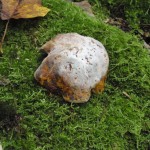 Perfect conditions that specific day made it possible for the forest floor to come alive; fungi aren’t present all the time. We saw species that looked like coral and some that looked like delicate lace. Fungi that looked like tiny fringe covered felled trees. Solid, slimy, and gelatin-like figures decorated the foliage. It wasn’t hard to stretch ones imagination and see golf balls, berries, crème brulee, and bread dusted with flour. Upon our arrival home we feverishly paged through books to find names for all of our new found friends. Unfortunately, fungi identification is much more difficult than that of reptiles, and so we are continuing the literature search for their Latin monikers.
Perfect conditions that specific day made it possible for the forest floor to come alive; fungi aren’t present all the time. We saw species that looked like coral and some that looked like delicate lace. Fungi that looked like tiny fringe covered felled trees. Solid, slimy, and gelatin-like figures decorated the foliage. It wasn’t hard to stretch ones imagination and see golf balls, berries, crème brulee, and bread dusted with flour. Upon our arrival home we feverishly paged through books to find names for all of our new found friends. Unfortunately, fungi identification is much more difficult than that of reptiles, and so we are continuing the literature search for their Latin monikers.
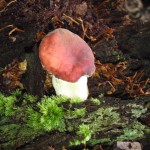 So many times as I have trekked through that same patch of forest in search of creatures and never have I witnessed such an incredible display of nature. It is truly a lesson that if we open our eyes, truly open our eyes, to our surroundings we are able to notice some incredible things that would otherwise go unseen. This bit of wisdom should not exclusively be true to science, but to life. What is it that we do not see in our everyday life? What about in our own backyard? As children we
So many times as I have trekked through that same patch of forest in search of creatures and never have I witnessed such an incredible display of nature. It is truly a lesson that if we open our eyes, truly open our eyes, to our surroundings we are able to notice some incredible things that would otherwise go unseen. This bit of wisdom should not exclusively be true to science, but to life. What is it that we do not see in our everyday life? What about in our own backyard? As children we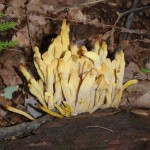 see both blindly and fully. The innocence of a child blinds them to judgment and bias, yet it also opens their eyes to the wonderment of the world and the idea that all things are possible. Imagine if, as adults, we still believed that anything was possible. I am extremely thankful to share an incredible trip with two wonderful people such as Andrew and Roger, and even more thankful for the fungus that was among us for reminding me that all things are possible.
see both blindly and fully. The innocence of a child blinds them to judgment and bias, yet it also opens their eyes to the wonderment of the world and the idea that all things are possible. Imagine if, as adults, we still believed that anything was possible. I am extremely thankful to share an incredible trip with two wonderful people such as Andrew and Roger, and even more thankful for the fungus that was among us for reminding me that all things are possible.